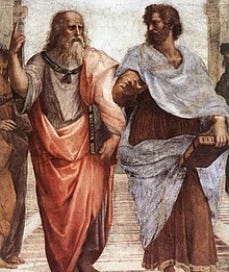The Three Laws of Logic
How The Law of Contradiction: ~(p . ~p) The Law of Excluded Middle: p v ~p and The Principle of Identity: A = A are used in our daily lives.
“The Laws of Logic were placed in our minds by the Creator during the act of creation.” - R.C. Sproul
The Laws of Logic are important and vital in all our lives. These laws are accepted as an objective foundation for rational thought. The Laws of Logic are used in our everyday lives and without it, we would make no sense of anything in life. Understanding these laws will help in making you a better thinker and will give you the tools to properly discern if a perspective is illogical.
This article will break down the three fundamental Laws of Logic.
The Law of Contradiction: ~(p . ~p)
The Encyclopedia Britannica provides a symbolic definition of the Law of Contradiction: “For all propositions p, it is impossible for both p and not p to be true, or: ~(p . ~p), in which ~ means ‘not’ and . means ‘and.’”
Merriam-Webster defines The Law of Contradiction as: “A principle in logic: a thing cannot at the same time both be and not be of a specified kind (as a table and not a table) or in a specified manner (as red or not red).”
Example 1
Chris Drew, PhD gives examples of logical contradictions in his article, 50 Contradiction Examples.
If Sally says an apple is red, but Mike says an apple is blue, they would land in a contradiction. Both Sally and Mike cannot be correct because an apple cannot be red and blue at the same time, one person has to be mistaken.
Example 2
“Nobody goes to the restaurant, it’s too crowded” (50 Contradiction Examples). If a restaurant is crowded people are going to a restaurant, which contradicts the first part of the sentence, “nobody goes to the restaurant.”
The Law of Excluded Middle: p v ~p
The Encyclopedia Britannica presents a symbolic definition of The Law of Excluded Middle,
p v ~p “v” means “or.”
Either p or ~p must be true, in which there is no third or middle true proposition between them, or: p v ~p, in which v means “or.”
p v ~p = p or not p
Example 1
The Law of the Excluded Middle article presents valid examples.
Suppose one says “It is my birthday today.” If today’s date matches the day you were born, the statement is true. If today’s date does not match the day you were born, the statement is false.
There is no alternative in this example, you cannot be born a little bit on a different day.
Example 2
Let’s analyze the phrase, “All crows are black.” The Law of Excluded Middle deems this as a true or false situation.
If you find even one crow that is not black, the statement is false. The statement is false because it says “all” crows are black, not “some.” (Law of Excluded Middle).
The Principle of Identity: A = A
Alexander Pfänder, author of Logic (Vol.3: Realist Phenomenology), explains the Principle of Identity: “This principle is usually symbolized by the formula: A = A, or A is A, or S is S. As examples, we can take the two judgments, ‘Sulfur is sulfur’ and ‘A state is a state.’ The principle of identity itself would then broadly mean: ‘Every object is identical with itself, or ; ‘Every object equals itself.’”
To simplify, The Principle of Identity just means that everything is identical to itself. (Pfänder).
Example 1
The Law of Identity: Explanation and Examples article provides sound examples.
The moon in the night sky is always the moon. The moon is not going to turn into a sun or a star because the moon’s identity is unique to it. The moon cannot be a sun or star because a moon is a moon and only has identities unique to the moon, not the sun or a star.
Example 2
If you name your cat “Fluffy,” that name refers to the same cat every single time you say it. The Law of Identity ensures that we know Fluffy is Fluffy in all situations, whether Flully is jumping, running, or playing, Fluffy remains Fluffy.


